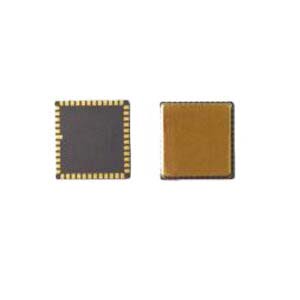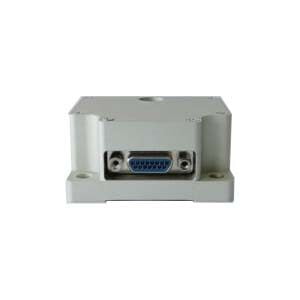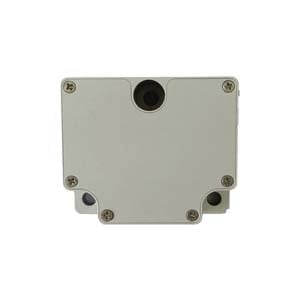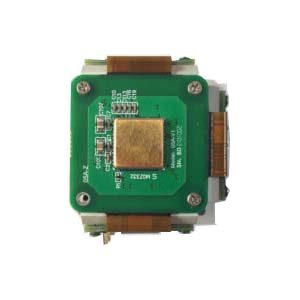Gyroscope, also known as angular velocity sensor, is an angular motion detection device that uses the relative inertia space of the moment of momentum sensitive shell of a high-speed rotating body around one or two axes orthogonal to the rotation axis. At the same time, the angular motion detection device made of other principles plays the same role as a device called gyroscope.
The origin of the name of gyroscope
The origin of the gyroscope's name has a long history. According to research, in 1850, in order to study the rotation of the earth, the French physicist Leon Foucault first found that the rotor of the ground in high speed rotation was rotor. Because of its inertia, its axis of rotation always pointed in a fixed direction. So Foucault named the instrument gyro scopei after the Greek words gyro (to spin) and skopein (to see).
The simple way of making the earliest gyroscope is as follows: put a high-speed spinning top on a universal bracket, and calculate the angular velocity based on the direction of the gyroscope. The simple figure is shown below.
Among them, the golden rotor in the middle is the gyroscope, which will not be affected due to the effect of inertia, and the three "steel rings" around it will change due to the change of the attitude of the equipment. Through this, the current state of the equipment can be detected. The axis where the three "steel rings" are located is the "three axes" in the three-axis gyroscope, namely the X axis, y axis and Z axis. The three-dimensional space surrounded by three axes jointly detects various movements, and then reads the direction indicated by the axes in various ways, and automatically sends data signals to the control system. So initially, the main purpose of the gyroscope was to measure angular velocity.
The basic components of a gyroscope
At present, when the motion of a gyroscope is analyzed approximately from the point of mechanics, it can be regarded as a rigid body with a universal fulcrum, and the gyroscope can rotate around this fulcrum with three degrees of freedom. Therefore, the motion of a gyroscope belongs to the rotational motion of a rigid body around a fixed point. To be more precise, a flywheel rotor rotating around the axis of symmetry at high speed is called a gyroscope. The gyroscope is installed on the frame device, so that the spin axis of the gyroscope has angular rotation of freedom, the overall device is called gyroscope.
The basic components of the gyroscope are: gyro rotor (often use synchronous motor, hysteresis motor, three-phase AC motor drag method to make the gyro rotor around the spin axis of high speed rotation, and see its speed is approximately constant); Inner and outer frame (or inner and outer ring, which is the structure that makes the gyro spin axis obtain the required angular rotation degree of freedom); Accessories (torque motor, signal sensor, etc.).
How a gyroscope works
The gyroscope detects angular velocity. It works on the principle of Coriolis forces: When an object moves in a straight line in a coordinate system, assuming the coordinate system does a rotation, the object feels a vertical force and an acceleration in the vertical direction during the rotation.
The formation of typhoons is based on this principle. The rotation of the earth drives the rotation of the atmosphere. If the rotation of the atmosphere is subjected to a tangential force, it is easy to form typhoons. The principle of Coriolis force is explained by a visual metaphor.
The gyroscope, in particular, is a central axis of a circle. In fact, there is no difference between the stationary gyroscope and the moving gyroscope itself, if the stationary gyroscope itself is absolutely balanced, except for the factor that the gyroscope can stand without rotation. If the size of the gyroscope is not balanced, it will cause the gyroscope model to tilt and fall at rest. Therefore, the unbalanced gyroscope must rely on rotation to maintain balance.
The gyroscope itself is related to gravity, and because of the effect of gravity, the heavy end of an unbalanced gyroscope will travel down, while the light end will go up. In the gravitational field, it takes time for the weight to fall. When the falling speed of the object is much slower than the rotation speed of the gyroscope itself, the gyroscope will be biased in focus, and the balance of the gyroscope itself will be constantly changed during rotation, and an upward rotation speed direction will be formed. Of course, if the gyroscope bias is too large, the gyroscope's own left and right forces will fail.
In rotation, if the gyroscope encounters external forces, a point of the gyroscope runner is stressed. The gyroscope will immediately tilt, and if the potential energy of the force point of the gyroscope is lower than the rotation speed of the gyroscope, then the force point will tilt because of the gyroscope. Under the push of rotation, the force point of the gyroscope will slide from the lower Angle of the oblique to the upper Angle of the oblique. However, when the upward angle of the syncline is running, the potential energy of the stress point of the gyroscope is still running downward. And that's going to cause when the gyroscope gets to the top angle of the slope, the remaining potential energy at the point of force is going to push down the potential energy at the top angle of the slope.
And the opposite end of the diameter of the force point, also has the corresponding potential energy, this potential energy is the opposite direction of the force point, the force point down, but it is up, and this point is called "linkage force point". When the linkage stress point rotates 180 degrees from the upper Angle to the lower Angle, then the linkage stress point pulls the gyroscope upward. Under the interaction of force point and linkage force, the gyroscope returns to equilibrium.
The axis of rotation of a rapidly rotating body tends to be perpendicular to external forces that change its direction. Moreover, when a rotating object tilts laterally, gravity acts in the direction of increasing the tilt, while the axis moves vertically, resulting in a motion of shaking the head (precession motion). When the gyro axis of gyro rotates in horizontal axis, due to the rotation of the earth, it is subjected to the rotation force in the straight direction, and the rotating body of the gyro generates precession motion in the direction of the meridian in the horizontal plane. It can be applied when the axis is parallel to the meridian and at rest.
The role of the gyroscope
What's the difference between a gyroscope and a gravity sensor? There are a lot of differences, but the biggest difference is that the gravity sensor has fewer dimensions of spatial displacement sensing, which is good enough to be able to sense six directions, while the gyroscope is omnidirectional. This is important, and it's no exaggeration to say that these two products are not on the same level.
If you look at this, you may feel a little confused, since the gyroscope is very good, so how can it be used on the phone? Let's take a look.
The first use is navigation. Gyroscopes have been used for navigation ever since they were invented. First, the Germans used them on V1 and V2 rockets. Therefore, if combined with GPS, the navigation ability of mobile phones will reach an unprecedented level. In fact, many professional handheld GPS devices are equipped with gyroscopes. If a mobile phone is equipped with the corresponding software, its navigation capability is as good as that of many ships and aircraft.
Second, it can be used with the camera on the phone, such as anti-shaking, which will greatly improve the ability of the phone to take pictures.
The third use is sensors for all kinds of games, such as flight games, sports games, and even some first-perspective shooting games. The gyroscope completely monitors the displacement of players' hands, so as to achieve various game operation effects. Anyone who has ever used a Nintendo WII will know this very well.
The fourth use, which can be used as an input device, is a gyroscope equivalent to a three-dimensional mouse, a function similar to the third use of gaming sensors, which can even be considered a type.
The fifth and most promising use in the future. Here are the highlights. That could help the phone do a lot of augmented reality. Augmented reality is a relatively recent concept that, like virtual reality, is an application of computers. The idea is to use the processing power of a mobile phone or a computer to give people a deeper understanding of objects in the real world. If you don't understand, for example, there is a building in front of you. If you point your mobile phone camera at it, you can immediately get the relevant parameters of the building on the screen, such as the height, width and elevation of the building. If you connect to the database, you can even get the owner of the building, the construction time, the current use, the number of people that can be accommodated and so on.
This augmented reality technology isn't just for curiosity. It could be used in a lot of practical applications, like building a house and knowing if a wall is crooked when you take a picture of it with your phone. How much is it skewed? For example, if you are an Iraqi resistance soldier, you only need to carry a mobile phone, go to the base and take a picture of any tank, armored vehicle or helicopter. Then you can immediately determine the type, speed and direction of the weapon.
The seven common gyroscopes
According to the inerTIa or rigidity and precession of gyroscope, the common gyroscopes are as follows:
Gyro compass. A three-degree-of-freedom gyroscope for finding and tracking geographic meridional planes for navigational and flying objects. The outer ring shaft is straight, the rotor shaft is placed horizontally in the meridional plane, and the positive end refers to the north; The center of gravity deviates from the center of support along the vertical axis of the lead down or up. When the rotor axis deviates from the meridional plane, it also deviates from the horizontal plane and generates a heavy moment to make the gyro precession to the meridional plane. This kind of gyro compass using heavy moment is called pendulum compass. In the 21st century, the electronically controlled gyrocompass is developed to use automatic control system instead of gravity pendulum, and to create a platform compass that can indicate both the horizontal plane and the meridional plane.
Rate gyroscope. A two - degree of freedom gyro device used to directly determine the angular velocity of a vehicle. Attach the outer ring of the equalizing gyroscope to the vehicle and make the inner ring axis perpendicular to the axis on which angular rate is to be measured. When the vehicle, along with the outer ring, precors about the measuring axis at angular velocity, the gyroscopic torque forces the inner ring, along with the rotor, to precort relative to the vehicle. There are springs in the gyroscope that limit this relative precession, and the precession Angle of the inner ring is proportional to the amount of deformation of the spring. The gyroscopic torque and the angular rate of the vehicle can be obtained from the inner ring precession Angle at equilibrium. The integral gyroscope differs from the rate gyroscope only in that a linear damper is used instead of a spring constraint. When the vehicle rotates at any speed, the output of the integrating gyroscope is the Angle of the measurement axis (that is, the integral of the angular velocity). The above two kinds of gyroscopes are widely used in remote measurement system or automatic control and inertial navigation platform.
Gyro stabilized platform. With gyroscope as the core component, the device that keeps the stabilized object stable relative to the given attitude in inertial space. The stable platform usually uses the torquer on the platform frame axis composed of the outer ring and the inner ring to generate the balance of torque and interference torque to stop the gyroscope precession. The stable platform is called the dynamic gyroscope stabilizer. According to the number of rotating axes that an object can maintain stability, gyrostabilized platforms can be divided into uniaxial, biaxial and triaxial gyrostabilized platforms. Gyro stabilized platform can be used to stabilize instruments and equipment that need accurate orientation, such as measuring instruments, antennas, etc., and has been widely used in aviation and navigation system and fire control, radar universal support. Various types of gyroscopes are used as components according to different principle schemes. The gyroscopic torque generated by gyroscopic precession is used to resist the interference torque, and then the signal control and camera system is output.
Gyroscope sensor. Gyro sensor is a simple and easy to use positioning and control system based on free space movement and gesture. By waving the mouse over an imaginary plane, the cursor on the screen moves and can circle links and click buttons. This can be done conveniently when you're giving a speech or leaving the table. Gyroscopic sensors, originally used in helicopter models, are already widely used in mobile devices such as mobile phones (the IPHONE's three-axis gyroscope technology).
Fiber optic gyroscope. The fiber optic gyroscope is a sensor based on the optical fiber coil. The light emitted by the laser diode travels along the optical fiber in two directions. The change of light propagation path determines the angular displacement of the sensor. Compared with the traditional mechanical gyroscope, the advantages of fiber optic gyroscope are all solid state, no rotating parts and friction parts, long life, large dynamic range, instantaneous start, simple structure, small size, light weight. Compared with laser gyroscope, optical fiber gyroscope has no locking problem, and does not need to be in the quartz block precision machining optical path, low cost.
Laser gyroscope. The principle of laser gyro is to measure the angular velocity of rotation (Sagnac effect) using the optical path difference. In the closed optical path, the rotation angular velocity of the closed optical path can be measured by detecting the change of phase difference or interference fringe when two beams of light transmitted clockwise and counterclockwise from the same light source are transmitted.
MEMS gyroscope. Mems-based gyros are much cheaper than fiber optic or laser gyros, but have very low accuracy and need to be compensated with reference sensors to improve accuracy. MEMS gyroscope relies on alternating coriolis forces caused by mutually orthogonal vibration and rotation. MEMS gyroscope uses Coriolis to convert the angular velocity of a rotating object into DC voltage signals proportional to the angular velocity. Its core components are mass-produced by doping, lithography, corrosion, LIGA and packaging technologies.
The application of gyroscope
Application of gyroscope in aerospace
Gyroscope instrument was first used in navigation, but with the development of science and technology, it has been widely used in aviation and aerospace industry.
Gyro instrument can not only be used as indicator, but more importantly, it can be used as a sensitive element in automatic control system, which can be used as signal sensor. According to needs, gyroscopic instruments can provide accurate signals such as azimuth, level, position, speed and acceleration, so that pilots or automatic navigators can control aircraft, ships or space shuttles to fly according to a certain course, and in the guidance of missiles, satellite vehicles or space exploration rockets and other vehicles, These signals can be used directly to control the attitude and orbit of the vehicle. Gyroscopic instruments can be used as stabilisers to keep trains on monorail, to reduce the sway of ships in wind and waves, to stabilize cameras mounted on aircraft or satellites relative to the ground, and so on.
As a precision test instrument, gyro instruments can provide accurate bearing datums for surface installations, mine tunnels, underground railroads, oil drilling, and missile silos.
It can be seen that the scope of application of gyroscope instrument is quite wide, it plays an important role in the construction of modern national defense and national economy.
Innovative application of gyroscope in consumer electronics
The appearance of gyroscope gives consumer electronics a lot of application space. For example, in terms of device input, after the keyboard, mouse and touch screen, the gyroscope brings us gesture input, and because of its high precision, it can even realize electronic signature. It is also about making smartphones smarter: in addition to surfing the web and processing data quickly, they can also "read people" and provide services accordingly.
Navigation. Gyroscopes have been used for navigation ever since they were invented. First, the Germans used them on V1 and V2 rockets. Therefore, if combined with GPS, the navigation ability of mobile phones will reach an unprecedented level. In fact, many professional handheld GPS devices are equipped with gyroscopes. If a mobile phone is equipped with the corresponding software, its navigation capability is as good as that of many ships and aircraft.
The camera resists shaking. The gyroscope can be used in conjunction with the camera on the phone, such as anti-shaking, which will greatly improve the phone's ability to take pictures.
Enhance the game experience. Sensors for all kinds of mobile games, such as flight games, sports games, and even some first-perspective shooting games, the gyroscope completely monitors the displacement of players' hands, so as to achieve a variety of game operation effects, such as horizontal screen to vertical screen, turning in racing games and so on.
As an input device. The gyroscope can also be used as an input device. It acts as a stereoscopic mouse, a function similar to the gaming sensor in the third most important use, and can even be considered a type.
At the same time, in addition to the smart phone we are familiar with, the car also uses a lot of MEMS gyroscope, in high-end cars, about 25 to 40 MEMS sensors, used to detect the working state of different parts of the car, to provide information to the driving computer, so that users better control the car.
More Technical Questions
1.What is the Difference between a Gyroscope sensor and an Acceleration Sensor?
2.Where are MEMS Gyroscopes Used?
3.MEMS gyroscopes, accelerometers and magnetometers
5.Where are MEMS Gyroscopes Used?
Products in Article







